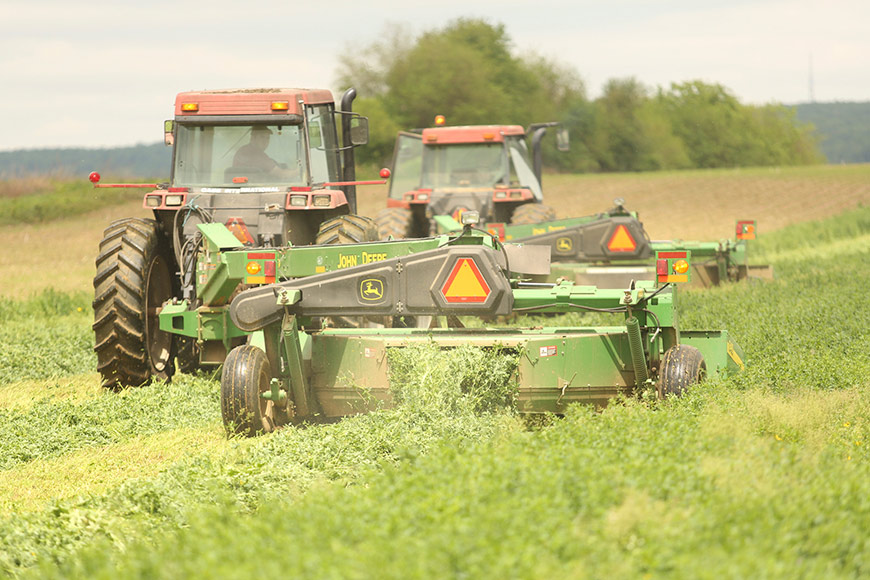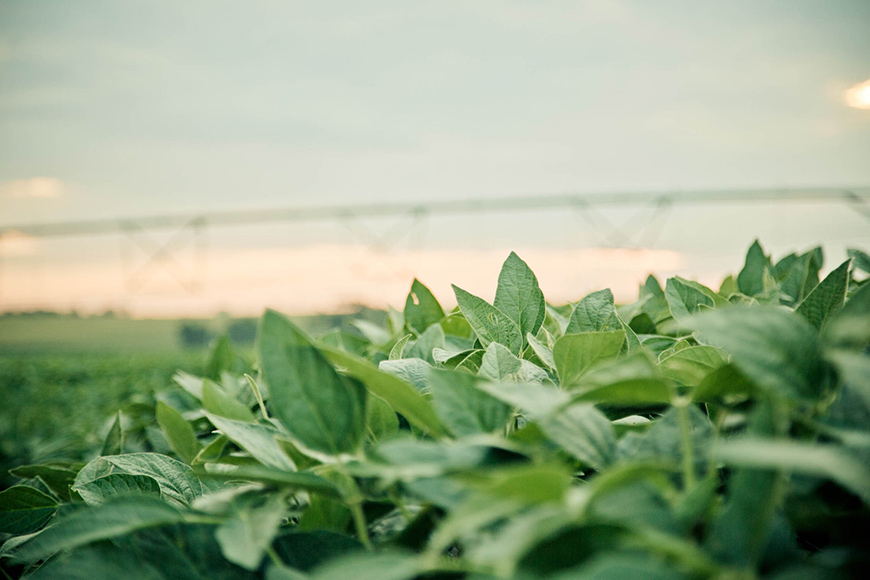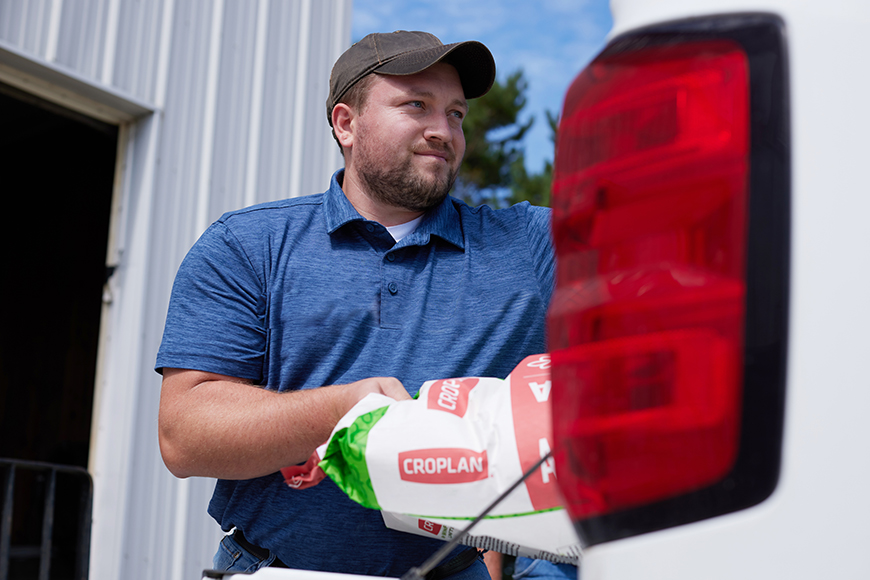Evolution in Alfalfa Trait Technology

If you grow alfalfa, you may have noticed that your new-seeding fields established particularly unevenly this year. Disease resistance during establishment in cold and wet soils may be one reason. Wet spring conditions can lead to situations that foster multiple races of aphanomyces root rot, phytophthora root rot, and stem and crown diseases such as anthracnose and pythium seedling blight. All can limit the establishment and yield of alfalfa fields.
Some soil diseases can be aggravated by soil compaction, which doesn’t allow water to readily exit the soil and increases disease severity. Alfalfa grows best in warm, dry conditions during establishment, and unfortunately warm and dry weather was not on our menu this spring. However, alfalfa genetics from CROPLAN® seed and seed treatments from WinField United offer features that can help alfalfa producers grow better established and more tons, even in challenging conditions.
Exciting developments are occurring in alfalfa technology that build on the strengths of previous generations of disease resistance. Specifically, they include higher levels of aphanomyces and anthracnose protection in seed genetics, as well as seed treatments that include Apron XL® fungicide and Stamina® fungicide, which can help inhibit the growth of various seedling diseases. Having these types of safeguards is pretty much a requirement for today’s alfalfa growers, and they can help protect your yield and ROI potential.
Here’s a brief look at some newer alfalfa varieties that are available.
Forage quality: HarvXtra Alfalfa modifies lignin content beyond what is possible with conventional breeding. It provides you with the flexibility to maintain your current harvest schedule for improved quality or to delay harvest for greater yield potential. And it comes stacked with Roundup Ready Technology for improved weed control and excellent crop safety. HarvXtra contains an average of 17 percent higher neutral detergent fiber digestibility (NDFD) when compared to conventional alfalfa at the same stage of maturity.1
Yield potential: Sometimes it isn’t possible to cut your alfalfa exactly at 30-day intervals. In fact, cutting at greater than 30-day intervals is less stressful on stands and may provide additional plant health and stand persistence, potentially eliminating a cutting. HarvXtra Alfalfa cut at 35 days averaged a 30 percent yield increase over three years when compared to Roundup Ready® Alfalfa cut at 28 days.2
Alfalfa is an excellent forage crop you can use to optimize the production of dairy cows, beef cattle or other ruminants. It complements other forages used in animal diets and even adds many soil benefits. Alfalfa is a good source of protein and nutrients and contains highly digestible fiber content. To help optimize forage production in your fields, consider planting CROPLAN Rebound AA, LegenDairy AA or HarvXtra MegaTron.
1. Data is an average of CROPLAN HarvXtra HarvaTron, MegaTron and Driver varieties harvested in 2014 and 2015 trials from Nampa, Idaho; Touchet, Wash.; Boone, Iowa; West Salem, Wis.; and Mt. Joy, Pa.
2. Source: Seeded Fall at West Salem, Wis. FGI 3-year trial, 2014-16.
All photos are either the property of WinField United or used with permission.
© 2021 WinField United.
Important: Before use, always read and follow label instructions. Crop performance is dependent on several factors, many of which are beyond the control of WinField United, including without limitation soil type, pest pressures, agronomic practices and weather conditions. Growers are encouraged to consider data from multiple locations over multiple years and be mindful of how such agronomic conditions could impact results.
ALWAYS READ AND FOLLOW PESTICIDE LABEL DIRECTIONS. Roundup Ready® crops contain genes that confer tolerance to glyphosate. Glyphosate herbicides will kill crops that are not tolerant to glyphosate.
Advanced Coating®, CROPLAN®, GroZone® and WinField® are trademarks of WinField United.
Roundup Ready® is a registered trademark of Bayer Group, used under license by Forage Genetics International, LLC.
HarvXtra® is a registered trademark of Forage Genetics International, LLC. HarvXtra® Alfalfa with Roundup Ready® Technology is enabled with Technology from The Samuel Roberts Noble Foundation, Inc.
Apron XL® is a trademark of A Syngenta Group Company.
Stamina® is a trademark of BASF Group.
Some soil diseases can be aggravated by soil compaction, which doesn’t allow water to readily exit the soil and increases disease severity. Alfalfa grows best in warm, dry conditions during establishment, and unfortunately warm and dry weather was not on our menu this spring. However, alfalfa genetics from CROPLAN® seed and seed treatments from WinField United offer features that can help alfalfa producers grow better established and more tons, even in challenging conditions.
Exciting developments are occurring in alfalfa technology that build on the strengths of previous generations of disease resistance. Specifically, they include higher levels of aphanomyces and anthracnose protection in seed genetics, as well as seed treatments that include Apron XL® fungicide and Stamina® fungicide, which can help inhibit the growth of various seedling diseases. Having these types of safeguards is pretty much a requirement for today’s alfalfa growers, and they can help protect your yield and ROI potential.
Here’s a brief look at some newer alfalfa varieties that are available.
Rebound AA (conventional)
One of the benefits of exceptional disease resistance is that it allows alfalfa plants to deliver rapid recovery after periods of extended wet soil stress. Enhanced disease resistance helps minimize the “root nibbling” by diseases that reduce water and nutrient uptake in the wet soil disease complex. An enhanced disease resistance package is found in Rebound AA alfalfa. Features and benefits include:- An exceptional defensive disease package that includes resistance to aphanomyces root rot disease (race 1 and race 2/3) and resistance to multiple races of anthracnose (including race 5).
- Resistance to phytophthora root rot, bacterial wilt, verticillium wilt and fusarium wilt.
- Outstanding yield potential starting with early spring growth and rapid regrowth following each cutting.
- Excellent stand persistence and winterhardiness; ideally adapted to a wide range of soils and conditions.
- Fall dormancy (FD) rating of 4.3 and winterhardiness (WH) rating of 1.7.
- Suitability for 4- to 5-cut harvest management systems. Great for haylage, baleage or baled hay options. Plant Rebound AA where you anticipate aphanomyces root rot and where anthracnose may be problematic.
- Availability with GroZone® plus Advanced Coating® Zn and Stamina fungicide seed treatment for exceptional early seedling growth.
LegenDairy AA (conventional)
With exceptional disease resistance and performance on wet soils, LegenDairy AA is ideal for baled hay, baleage or haylage. LegenDairy AA works well in mixed alfalfa stands when baled hay is often needed. This variety offers excellent forage quality and will be available for planting in 2020. Features and benefits of LegenDairy AA include:- An exceptional defensive disease package that includes resistance to aphanomyces root rot disease (race 1 and race 2/3) and resistance to multiple races of anthracnose (including new race 5).
- Resistance to phytophthora root rot, bacterial wilt, verticillium wilt and fusarium wilt.
- Exceptional yield potential with great overall plant health and leaf retention for strong forage quality.
- Excellent winterhardiness, making this variety a great choice for farmers in northern growing regions. It also moves well from east to west.
- Fall dormancy (FD) rating of 3.4 and winterhardiness (WH) rating of 1.1.
- Suitability for 3- or 4-cut baled hay, baleage or haylage harvest systems.
- Availability with GroZone plus Advanced Coating Zn and Stamina fungicide seed treatment for exceptional early plant health.
HarvXtra Alfalfa
Having a flexible cutting window for your alfalfa stands helps you meet your operational goals, which leads to increased ROI potential. The option to extend harvest up to 10 days lets you choose between higher quality potential or higher yield potential. These opportunities are yours with HarvXtra® Alfalfa with Roundup Ready® Technology.Forage quality: HarvXtra Alfalfa modifies lignin content beyond what is possible with conventional breeding. It provides you with the flexibility to maintain your current harvest schedule for improved quality or to delay harvest for greater yield potential. And it comes stacked with Roundup Ready Technology for improved weed control and excellent crop safety. HarvXtra contains an average of 17 percent higher neutral detergent fiber digestibility (NDFD) when compared to conventional alfalfa at the same stage of maturity.1
Yield potential: Sometimes it isn’t possible to cut your alfalfa exactly at 30-day intervals. In fact, cutting at greater than 30-day intervals is less stressful on stands and may provide additional plant health and stand persistence, potentially eliminating a cutting. HarvXtra Alfalfa cut at 35 days averaged a 30 percent yield increase over three years when compared to Roundup Ready® Alfalfa cut at 28 days.2
HarvXtra MegaTron
Introduced in 2019, MegaTron is the newest variety with the HarvXtra trait. HarvXtra MegaTron delivers a wide range of features and benefits, including Roundup Ready weed control and the exceptional quality delivered with the HarvXtra trait. It has resistance to aphanomyces root rot for race 1 and race 2/3 in addition to multirace anthracnose resistance. And it’s available with GroZone plus Advanced Coating Zn and Stamina fungicide seed treatment for exceptional early plant health.Don’t forget the basics of alfalfa management
Just because alfalfa traits are evolving doesn’t mean you can reduce your alfalfa management. Here are a few fundamentals to remember:- A neutral soil pH (6.8 to 7.0) is critical to alfalfa success. Perform soil tests to check your pH levels.
- The ideal planting depth in spring is 3/8 to 1/2 inch below the soil surface. Plant deeper in late summer.
- Always review herbicide carryover risk from the previous crop before seeding alfalfa.
- At a minimum, potassium levels should be 150 parts per million (ppm) on a soil test.
- The minimum level for phosphorus on a soil test is 25 ppm.
- Apply a minimum of 25 lbs. of sulfur per acre annually or about 5 lbs. per ton of expected forage.
- Use a tissue test to determine boron need; a level of 40 ppm in alfalfa plant tissue is required; optimal sulfur level is about 0.30 percent on a tissue test.
- Control insects, especially potato leafhoppers (one insect per 10 sweeps is considered the economic threshold) and alfalfa weevils (apply an insecticide if 40 percent of your alfalfa crop shows any feeding).
Alfalfa is an excellent forage crop you can use to optimize the production of dairy cows, beef cattle or other ruminants. It complements other forages used in animal diets and even adds many soil benefits. Alfalfa is a good source of protein and nutrients and contains highly digestible fiber content. To help optimize forage production in your fields, consider planting CROPLAN Rebound AA, LegenDairy AA or HarvXtra MegaTron.
1. Data is an average of CROPLAN HarvXtra HarvaTron, MegaTron and Driver varieties harvested in 2014 and 2015 trials from Nampa, Idaho; Touchet, Wash.; Boone, Iowa; West Salem, Wis.; and Mt. Joy, Pa.
2. Source: Seeded Fall at West Salem, Wis. FGI 3-year trial, 2014-16.
All photos are either the property of WinField United or used with permission.
© 2021 WinField United.
Important: Before use, always read and follow label instructions. Crop performance is dependent on several factors, many of which are beyond the control of WinField United, including without limitation soil type, pest pressures, agronomic practices and weather conditions. Growers are encouraged to consider data from multiple locations over multiple years and be mindful of how such agronomic conditions could impact results.
ALWAYS READ AND FOLLOW PESTICIDE LABEL DIRECTIONS. Roundup Ready® crops contain genes that confer tolerance to glyphosate. Glyphosate herbicides will kill crops that are not tolerant to glyphosate.
Advanced Coating®, CROPLAN®, GroZone® and WinField® are trademarks of WinField United.
Roundup Ready® is a registered trademark of Bayer Group, used under license by Forage Genetics International, LLC.
HarvXtra® is a registered trademark of Forage Genetics International, LLC. HarvXtra® Alfalfa with Roundup Ready® Technology is enabled with Technology from The Samuel Roberts Noble Foundation, Inc.
Apron XL® is a trademark of A Syngenta Group Company.
Stamina® is a trademark of BASF Group.





